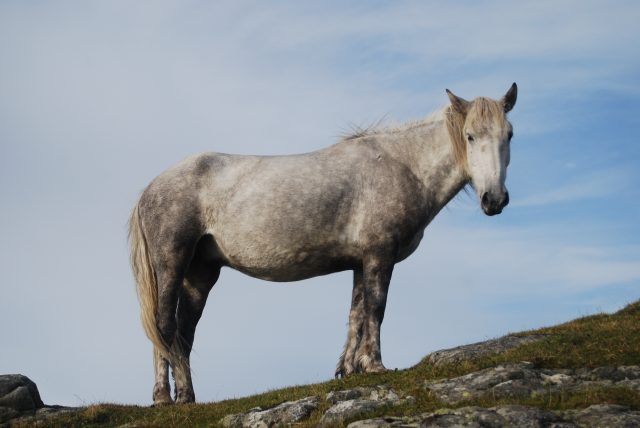Type the name of the breed you're looking for below
[wpdreams_ajaxsearchlite] Don't see the breed your're looking for? Click here and let us know!
Eriskay pony
| Country Of Origin | Scotland |
| History and Background | The Eriskay Pony is a breed of pony from Scotland. It is generally grey in colour, and has a dense, waterproof coat that protects it in harsh weather. The breed developed in ancient times in the Hebrides islands in Scotland, and a small population remained pure and protected from crossbreeding by the remoteness of the islands. It is used for light draught work, as a mount for children, in many equestrian disciplines, and for driving. The breed is rare today, with the Rare Breeds Survival Trust considering their status critical. There are two breed registries for the Eriskay, the first formed in 1971 and the second in 1986. The Eriskay Pony developed in the Hebrides, a group of western isles in Scotland. The origins of the breed are ancient, with roots in Celtic and Norse breeding. It is physically similar to drawings of ponies on ancient Pictish stones found in north and west Scotland. It is related to other northern breeds, including the Icelandic horse and the Faroe pony. The Eriskay takes its name from the island of Eriskay in the Outer Hebrides. Originally, the breed had a fairly large population, and until the mid-19th century the Eriskay and similar ponies were found throughout the western islands of Scotland. They were used as crofters' ponies, as pack animals, for light draught and as mounts for children. During the 19th century numbers were much reduced through increased crossbreeding. The crossbreeding was used to produce larger ponies for draught work, and Eriskays and other island ponies were crossed with horse breeds from mainland Europe, including Arabs and Clydesdales. Other horses, including the Norwegian Fjord, were crossed with island ponies, including the Eriskay, to produce the Highland pony. A few specimens of the Eriskay were preserved on the remotest islands of Scotland, mainly due to the difficulties of accessing the islands. This stock of ponies remained pure, but through the advent of mechanisation, declined in population to around 20 animals in the early 1970s. In 1941 the SS Politician foundered off the Eriskay coast, and the islanders, using the Eriskay ponies, carried away the cargo of 250,000 bottles of whisky. Today the Eriskay is rare. Its population is considered to be at critical status by the UK-based Rare Breeds Survival Trust, meaning that there are 300 or fewer breeding females registered in the world today. In 2006, there were believed to have been around 300 mares and 4 purebred stallions, and by 2009 this number had risen to around 420 ponies worldwide. It is possible that the Eriskay is the last surviving Hebrides pony breed. There are two breed registries that represent the breed. The first (the Eriskay Pony (Purebred) Studbook Society or Comann Each nan Eilean, formed in 1971 has the goal of maintaining the purity of the Eriskay breed, and disallows all crossbreeding. The second (the Eriskay Pony Society, formed in 1986 aims to produce ponies with desirable traits, which the registry feels will help promote their survival – this registry has considered the possibility of cross-breeding. The Eriskay Pony Society achieved legal recognition as a breed society and passport issuing organisation for the UK in 1995; Comann Each nan Eilean did not receive legal recognition until 2002. In addition to the domesticated ponies there is a small herd of Eriskay ponies living in a feral state on the Holy Isle. These ponies are descended from a group of five ponies brought to the Holy Isle to when it was owned by the Universities Federation for Animal Welfare in the 1970s to form a nature reserve. Today the island is owned by the Samye Buddhist Centre for World Peace and Health. They operate a policy of non-intervention, allowing the ponies to live without human interference. |
| Use Today | Pleasure pony, Show pony, Riding pony, Light draft work. |
| Height | 12 and 13.2 hands (48 and 54 inches, 122 and 137 cm) |
| Colour | Bay, Black, Grey |
| Characteristics | It is usually grey in colour, although a few are bay or black. Dark coloured animals generally have the pangaré characteristics of a light-coloured muzzle and ring around their eye. However, according to breed standards, they should not have an eel stripe. Chestnut, piebald, skewbald and excess white markings are discouraged by breed registries. The winter coat is dense and waterproof to protect from the harsh climate, with a thick mane and tail. The head is large, with a wide forehead. The neck and shoulders are well muscled, and the chest deep but generally not broad. The rib-cage is long and the loins short, which increases the strength of the back. The croup is slightly sloping. It is quite similar to the Exmoor pony in body type. The Eriskay has an easy-going temperament and is suitable as a mount for children. It is used for light draught work, as well as dressage, show jumping, three-day eventing, western riding and driving. Eriskays have successfully competed in combined driving at highly competitive international level competitions sanctioned by the Fédération Équestre Internationale. They have also been used in therapeutic horse-riding. |
| Personality and Temperament | The Eriskay Pony is said to have an amiable and placid nature, which in combination with its small size, makes it one of the most suitable mounts for children and novice riders. The breed is easy to tame and highly trainable, as evinced by its great success in driving competitions. In fact, some claim that it takes less time to train an Eriskay Pony than any other horse breed. |



